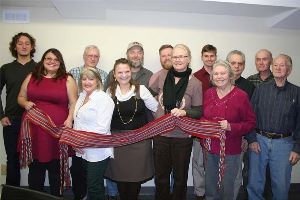Written by Craig Bakay of frontenacnews.ca
From: http://www.frontenacnews.ca/component/k2/item/11143-project-underway-to-collect-preserve-metis-traditional-knowledge

Participants in MNO High Land Waters Métis
Council Traditional Knowledge and Land Use
workshop January 21 in Flinton. (Back row l-r)
Nicolas Delbaeer-Sawchuck, Ford VanNess, Scott
Lloyd, Markus Tuohimaa, Steven Gautreau, James
Grand, Alfred Veley (front l-r) Ashley Lloyd, Darlene
Loft, Candace Lloyd, Carol Belanger, Trudy Conner
and Jim Conner. Click here for larger picture.
It’s a huge project, but Candace Lloyd, Secretary-Treasurer of the Métis Nation of Ontario (MNO) High Land Waters Métis Council is optimistic that a project to map and preserve Traditional Knowledge and Land Use as it pertains to the Métis way of life is doable and worthwhile.
The Métis way of life represents all aspects of “being Métis,” including a tightly woven relationship with the environment for food, spiritual and cultural fulfillment, medicine and ceremony.
The idea of the project is to interview members of the Métis community about all aspects of traditional knowledge and land use and then preserve that knowledge with map overlays and videos, for use by future generations.
The MNO High Land Waters Council is responsible for an area that stretches from Cardiff in the northwest, down to Trenton and Prince Edward County, over to Kingston (including Frontenac Islands) and up to Smiths Falls in the northeast.
Last Saturday, Lloyd, along with her Council, grant proposal writer Darlene Loft, interviewer/videographer Ashley Lloyd and Traditional Knowledge coordinator Markus Tuolimaa and GIS specialist Steve Gautreau held a workshop in Flinton to collect information and get the word out.
Lloyd said there are many benefits to such a project. Not only will knowledge be preserved, it will also serve as reference and educational material.
“We will be able to say ‘you’re not going to find ginseng there’ and suggest that a potential wind or solar project be moved slightly because it’s on a moose trail or blueberry patch,” Lloyd said.
Tuolimaa said this is how they use the lands and waters.
“There has always been an oral history tradition,” said Gautreau. “Now we’re doing actual mapping of things like where the stories took place, where and what animals were hunted and where and what plants were gathered.”
He said they try to maintain a certain amount of confidentiality but generally they’re interested in game harvesting, fishing, trapping line, plants and natural medicines, access points and cultural sites.
“It’s not a free-for-all knowledge thing,” Lloyd said. “But we would like to know things like this-is-a-moose trail or this-is-a-rabbit swamp. If it flies, swims, walks or you can pick it, that’s the information we want.”
Lloyd said they’re also hopeful this will lead to jobs for Métis people. “Who better to work on solar projects or mines than someone who knows the land?” she concluded.
Posted January 27, 2017
